Different Types of Birth Attendants Explained
Who you invite into your birth space is one of the most important decisions you will make during pregnancy. Whoever is present while you are in the birth process will inevitably affect the outcome of your birth. An attendant who is respectful of your wishes and knowledgeable about physiological birth can provide great comfort during birth. An attendant who you are uncomfortable with, has their own agenda, or is disruptive in any way can lead to complications. Learn more about that here.
For women birthing in the hospital, there is not much control over who is in their birth space. She will get whoever is working that shift and there might even be a shift change where a whole new team will come on. Some women don’t mind this but for women wanting a natural and undisturbed birth strangers in their birth space won’t due. When birthing at home women are able to choose who they want to attend their birth and fire them if the relationship isn’t working.
Below I explain the difference between different types of birth attendants who attend births at home - midwives, doulas, traditional birth attendants, and birthkeepers.
Watch the video here.
Medical Midwives
There are a few types of Medical Midwives - Certified Professional Midwves(CPM), Certified Nurse Midwives(CNM), and Direct Entry Midwives(DEM).
Certified Professional Midwives are governed and regulated by the North American Registry of Midwives (NARM). There are a few different ways that CPMs can gain credentials. Typically CPMs will complete a four-year bachelor's degree from a MEAC accredited midwifery program and then complete an apprenticeship under an NARM-certified preceptor. There is also an apprenticeship option called the Portfolio Evaluation Process (PEP) that does not require any formal higher education. Many state licensing bodies do not accept the PEP route while licensing CPMs and it is mandatory to attend a MEAC accredited program to receive a state license.
Certified Nurse Midwives are advanced practice nurses who received specialized medical midwifery training in addition to a bachelor’s degree in nursing. These midwives typically work in hospitals and occasionally work in a freestanding birth center or homebirth midwifery practice. These midwives are regulated and licensed by the state board of nursing.
Direct Entry Midwives are medical midwives who did not attend specialized schooling to become a midwife. Typically, these midwives complete an apprenticeship to learn midwifery skills. These midwives are only legal in areas without licensure.
Doulas
Doulas do not act as medical providers and are not licensed by any state or organization. Doulas can register with or get a certificate from certain organizations, such as DONA International. There are many different styles of doulas. Doulas can attend any kind of birth, in any setting, with or without a medical provider present. Most doulas attend predominantly hospital births and are not educated in natural or physiological birth processes or support techniques. Many doulas are not comfortable attending births outside the system, without a medical provider in attendance. If hiring a doula, it is essential to make sure that their philosophies align with yours and that they understand exactly what kind of birth support you are requesting from them. In a later section, I have example interview questions and more information about birth support options.
Traditional Birth Attendants/Birthkeepers/Nonmedical Midwives
A Traditional Birth Attendant is a Community Midwife who does not perform any medical procedures. These birth attendants specialize in supporting birth outside the medical system. Sometimes these attendants will refer to themselves as doulas or freebirth doulas. The title Birthkeeper was popularized by Emilee Saldaya and Yolande Norris-Clark’s Radical Birthkeeper School. There is no regulation for women who attend births outside of the system.
Prenatal support in this nonmedical model focuses on holistic support(nutrition, movement, exercise, thoughts, feelings, emotions, and spiritual beliefs), rather than medical assessments, observations, and interventions. This style of support recognizes the mother as the authority of her health, wellness, and birth. In the medical model, the doctor or medical midwife is seen as the authority and expert. This can create a power dynamic where the woman does not take full responsibility for her pregnancy and birth by outsourcing that responsibility to this authority figure.
I refer to myself as a Traditional Birth Attendant because the word midwife has been stolen by the state and the Medical Industrial Complex. Where I live, if I were to call myself a midwife I would need to be licensed with the state and regulated by the Board of Midwifery. If I call myself and midwife and do not license myself I could face legal repercussions. I cannot serve women as a Licensed Midwife because it goes against my principles and ethics. I do not morally agree with the governing organization NARM or the regulations for Medical Midwives in the state I live in.
For example, it is illegal for Medical Midwives to attend births at home where a woman is experiencing certain variations of normal (breech, twins, vaginal birth after caesarean, etc). If I were a Licensed Midwife I would need to abandon these women and suggest they birth at the hospital. Based on my experience and knowledge, I KNOW these are simply variations of normal and I have seen women with these variations birth their babies safely at home.
The word Midwife means “with woman”. I feel that I cannot serve women in full integrity if I am being restricted by the state and a governing board. Historically, a midwife was a wise woman in a community who supported women through pregnancy, birth, postpartum, and performed other healing practices. She used herbs and natural remedies to heal and support women. Women birthed this way for centuries before doctors began to pathologize and medicalize the birth process. This is the traditional way of birth. This is undisturbed birth. This is physiological birth.
